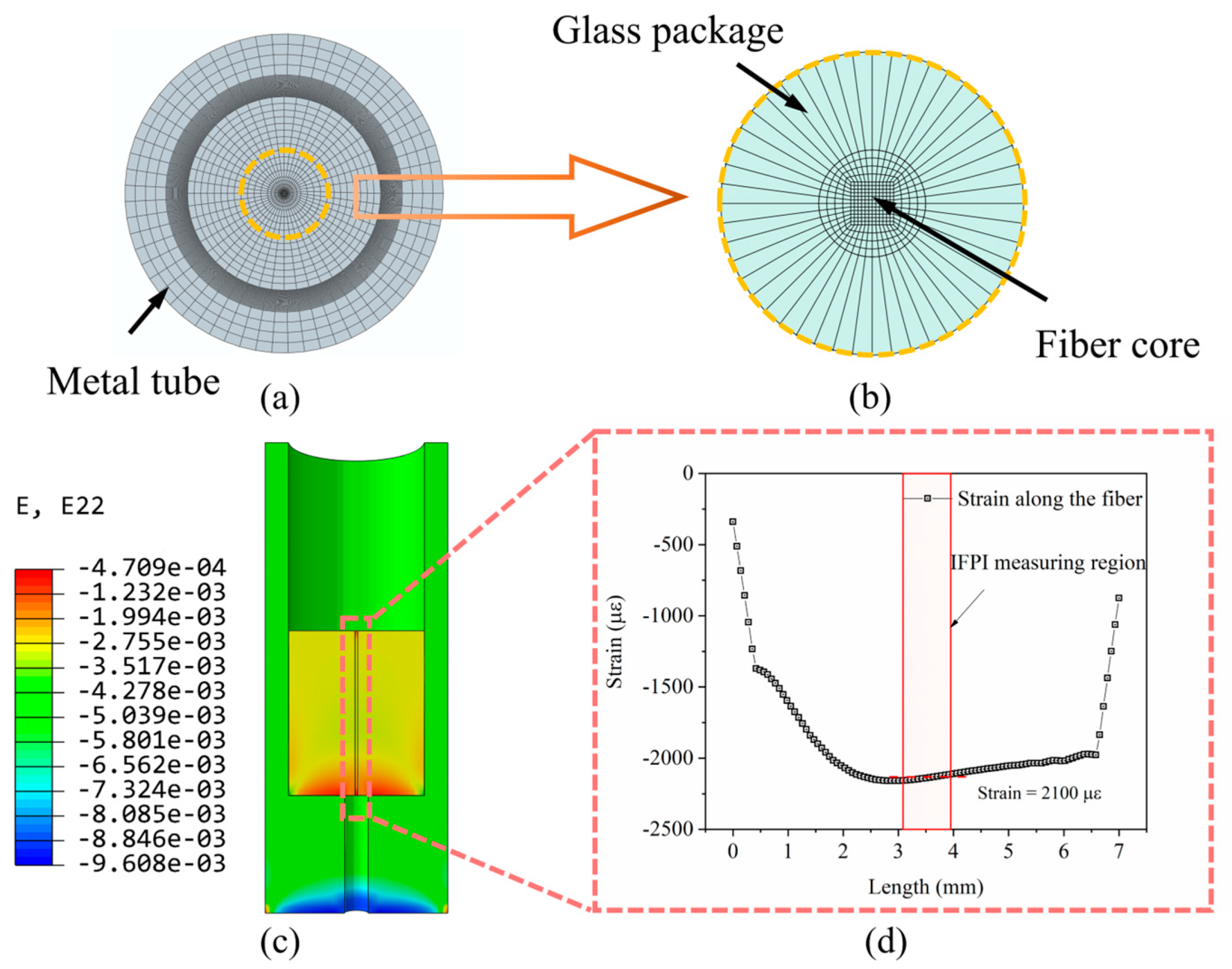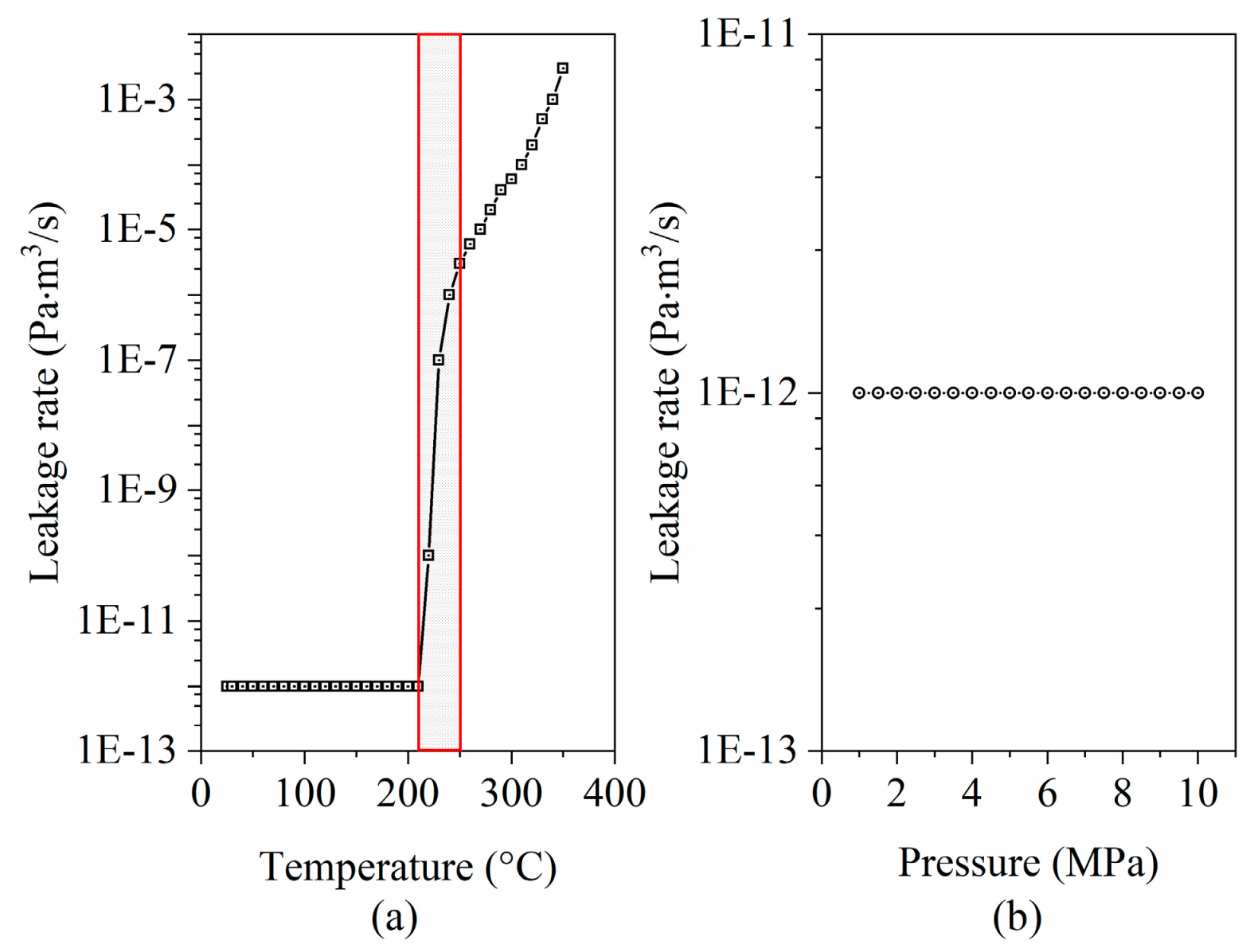A Hermetic Package Technique for Multi-Functional Fiber Sensors through Pressure Boundary of Energy Systems Based on Glass Sealants
Abstract
:1. Introduction
2. Experimental Design and Setup
2.1. IFPI Demodulation Method
2.2. Package Fabrication
2.3. Leakage Detection and Pressure Monitoring Experiment
3. Numerical Simulation
4. Results and Discussion
4.1. Fabrication Monitoring and Strain Measuring
4.2. Leakage Detection and Pressure Monitoring
5. Conclusions and Future Work
- (1)
- The temperature measuring results of IFPI were precise and consistent during the fabrication process, with a deviation of less than 0.001%, and the calibrated temperature sensitivity was almost the same as the theoretical value obtained from Equation (2).
- (2)
- The IFPI was able to measure the small-scale strain in the glass package during the curing process. The specific value of 1675 με was close to the numerical results of 1950 με obtained via finite element analysis (deviation less than 13%).
- (3)
- The hermeticity of the glass sealant package was demonstrated to be feasible at high temperatures (20~250 °C) and high pressure (1~10 MPa).
Author Contributions
Funding
Institutional Review Board Statement
Informed Consent Statement
Data Availability Statement
Acknowledgments
Conflicts of Interest
References
- Kim, H.J.; Shin, H.Y.; Pyeon, C.H.; Kim, S.; Lee, B. Fiber-optic humidity sensor system for the monitoring and detection of coolant leakage in nuclear power plants. Nucl. Eng. Technol. 2020, 52, 1689–1696. [Google Scholar] [CrossRef]
- Berruti, G.M.; Vaiano, P.; Quero, G.; Das Neves, T.F.P.; Boniello, A.; Consales, M.; Petagna, P.; Cusano, A. Analysis of uncoated LPGs written in B-Ge doped fiber under proton irradiation for sensing applications at CERN. Sci. Rep. 2020, 10, 1344. [Google Scholar] [CrossRef] [PubMed]
- Goossens, S.; De Pauw, B.; Geernaert, T.; Salmanpour, M.S.; Khodaei, Z.S.; Karachalios, E.; Saenz-Castillo, D.; Thienpont, H.; Berghmans, F. Aerospace-grade surface mounted optical fiber strain sensor for structural health monitoring on composite structures evaluated against in-flight conditions. Smart Mater. Struct. 2019, 28, 065008. [Google Scholar] [CrossRef]
- Berri, P.C.; Dalla Vedova, M.D.L.; Maggiore, P.; Scolpito, T. Feasibility study of FBG-based sensors for prognostics in aerospace applications. J. Phys. Conf. Ser. 2019, 1249, 012015. [Google Scholar] [CrossRef]
- Zhong, S.; Zhao, K.; Fan, Z.; Wu, J.; Li, Y.; Wang, Q.; Chen, K.P. Hermetic fiber sensor packaging through pressure boundary for harsh environment applications. In Proceedings of the 27th International Conference on Optical Fiber Sensors, Alexandria, VA, USA, 29 August–2 September 2022. [Google Scholar]
- Wang, Q.; Zhao, K.; Badar, M.; Yi, X.; Lu, P.; Buric, M.; Mao, Z.H.; Chen, K.P. Improving OFDR distributed fiber sensing by fibers with enhanced Rayleigh backscattering and image processing. IEEE Sens. J. 2022, 22, 18471–18478. [Google Scholar] [CrossRef]
- Wang, Q.; Lalam, N.; Zhao, K.; Zhong, S.; Zhang, G.; Wright, R.; Chen, K.P. Simulation Analysis of Mode Hopping Impacts on OFDR Sensing Performance. Photonics 2024, 11, 580. [Google Scholar] [CrossRef]
- Yi, X.; Li, Y.; Zhao, K.; Wu, Z.; Wang, Q.; Liu, B.; Buric, M.; Wright, R.; Chen, K.P. CO2 laser tapering of intrinsic Fabry–Perot interferometers for sensing. IEEE Sens. J. 2023, 23, 5824–5830. [Google Scholar] [CrossRef]
- Zhao, K.; Zhong, S.; Li, Y.; Ahmed, Z.; Kawaji, M.; Chen, K.P. Multiplexable fiber Bragg grating flow sensor enabled by femtosecond laser. Proc. SPIE 2023, 12532, 125320H. [Google Scholar] [CrossRef]
- Li, Y.; Zhao, K.; Zhao, J.; Wang, J.; Wright, R.; Buric, M.; Chen, K.P. Super-resolution demodulation for fiber sensor arrays based on the MUSIC algorithm. Opt. Lett. 2022, 47, 2390–2393. [Google Scholar] [CrossRef]
- Cao, R.; Yang, Y.; Wang, M.; Yi, X.; Wu, J.; Huang, S.; Chen, K.P. Multiplexable intrinsic Fabry–Perot interferometric fiber sensors for multipoint hydrogen gas monitoring. Opt. Lett. 2020, 45, 3163–3166. [Google Scholar] [CrossRef]
- Domínguez-Flores, C.E.; Monzón-Hernández, D.; Minkovich, V.P.; Rayas, J.A.; Lopez-Cortes, D. In-Fiber Capillary-Based Micro Fabry-Perot Interferometer Strain Sensor. IEEE Sens. J. 2019, 20, 1343–1348. [Google Scholar] [CrossRef]
- Kanawade, R.; Kumar, A.; Pawar, D.; Late, D.; Mondal, S.; Sinha, R.K. Fiber optic Fabry–Perot interferometer sensor: An efficient and fast approach for ammonia gas sensing. JOSA B 2019, 36, 684–689. [Google Scholar] [CrossRef]
- Paixão, T.; Araújo, F.; Antunes, P. Highly sensitive fiber optic temperature and strain sensor based on an intrinsic Fabry–Perot interferometer fabricated by a femtosecond laser. Opt. Lett. 2019, 44, 4833–4836. [Google Scholar] [CrossRef] [PubMed]
- Peng, Z.; Wang, M.; Huang, S.; Zou, R.; Wu, J.; Wang, Q.; Chen, K.P. Intrinsic Fabry–Perot interferometer fiber sensor by femtosecond laser induced Rayleigh backscattering enhancement. In Proceedings of the Conference on Lasers and Electro-Optics (CLEO), San Jose, CA, USA, 5–10 May 2019. [Google Scholar]
- Zhao, J.; Dong, W.; Hinds, T.; Li, Y.; Splain, Z.; Zhong, S.; Wang, Q.; Bajaj, N.; To, A.; Ahmed, M.; et al. Embedded fiber Bragg grating (FBG) sensors fabricated by ultrasonic additive manufacturing for high-frequency dynamic strain measurements. IEEE Sens. J. 2024, 24, 2853–2862. [Google Scholar] [CrossRef]
- Biswas, P.; Bandyopadhyay, S.; Kesavan, K.; Parivallal, S.; Sundaram, B.A.; Ravisankar, K.; Dasgupta, K. Investigation on packages of fiber Bragg grating for use as embeddable strain sensor in concrete structure. Sens. Actuators A Phys. 2010, 157, 77–83. [Google Scholar] [CrossRef]
- Wang, Q.; Zhao, K.; Yi, X.; Zhao, J.; Zhong, S.; Chen, K.P. Low-Cost OFDR Distributed Sensing Based on Optical Fiber with Enhanced Rayleigh Backscattering Profiles and Median Filtering. In Proceedings of the 27th International Conference on Optical Fiber Sensors, Alexandria, VA, USA, 29 August–2 September 2022; paper Th4.48. [Google Scholar]
- Wang, Q.; Zhao, K.; Zhong, S.; Yi, X.; Zhao, J.; Gribok, A.V.; Chen, K.P. Detection of Ultrasonic Guided Waves Using Fiber Optical Sensors Toward Nondestructive Evaluation. In Proceedings of the 27th International Conference on Optical Fiber Sensors, Alexandria, VA, USA, 29 August–2 September 2022; paper Th4.55. [Google Scholar]
- Hernández-Romano, I.; Monzón-Hernández, D.; Moreno-Hernández, C.; Villatoro, J. Highly sensitive temperature sensor based on a polymer-coated microfiber interferometer. IEEE Photonics Technol. Lett. 2015, 27, 2591–2594. [Google Scholar] [CrossRef]
- Yan, W.; Ma, S.; Wang, H.; Zhang, X. Fiber Bragg grating online packaging technology based on 3D printing. Opt. Laser Technol. 2020, 131, 106443. [Google Scholar] [CrossRef]
- Sweeney, D.C.; Schrell, A.M.; Liu, Y.; Petrie, C.M. Metal-embedded fiber optic sensor packaging and signal demodulation scheme towards high-frequency dynamic measurements in harsh environments. Sens. Actuators A Phys. 2020, 312, 112075. [Google Scholar] [CrossRef]
- Yang, J.; Yuan, L. Package and installation of embeddable fiber optic sensors. Opt. Lasers Eng. 2009, 47, 1085–1090. [Google Scholar] [CrossRef]
- Li, X.C.; Prinz, F.; Seim, J. Thermal behavior of a metal embedded fiber Bragg grating sensor. Smart Mater. Struct. 2001, 10, 575. [Google Scholar] [CrossRef]
- Rosolem, J.B.; Penze, R.S.; Bassan, F.R.; Floridia, C.; Peres, R.; Dini, D.C.; Vasconcelos, D.; Junior, M.A.R. Electroless nickel-plating sealing in fbg pressure sensor for thermoelectric power plant engines applications. J. Light. Technol. 2019, 37, 4791–4798. [Google Scholar] [CrossRef]
- Kreutzmann, G. Solder glass-sealing technology for use in packaging of fiber optic sensors. Fiber Opt. Sens. IV 1990, 1267, 2–8. [Google Scholar]
- Yanez, J.; Kuznetsov, M.; Souto-Iglesias, A. An analysis of the hydrogen explosion in the Fukushima-Daiichi accident. Int. J. Hydrogen Energy 2015, 40, 8261–8280. [Google Scholar] [CrossRef]
- Fan, Z.; Diao, X.; Zhang, Y.; Liu, M.; Chen, F.; Huang, Z.; Yan, H. Analysis of Residual Stress in Electrical Penetration Assembly Based on a Fiber Bragg Grating Sensor. Sensors 2018, 19, 18. [Google Scholar] [CrossRef] [PubMed]
- Fan, Z.; Diao, X.; Hu, K.; Zhang, Y.; Huang, Z.; Kang, Y.; Yan, H. Structural health monitoring of metal-to-glass–ceramics penetration during thermal cycling aging using femto-laser inscribed FBG sensors. Sci. Rep. 2020, 10, 12330. [Google Scholar] [CrossRef]
- Zhong, S.; Sharma, J.; Chen, K. Optical fiber-based novel quasi-distributed pressure sensing. Proc. SPIE 2023, 12665, 126650K. [Google Scholar] [CrossRef]
- Fan, Z.; Diao, X.; Liu, M.; Zhang, Y.; Huang, Z.; Yan, H. On-line monitoring of sealing glass in electrical penetration assembly based on femto-laser inscribed fiber Bragg grating sensors. Opt. Express 2019, 27, 608–620. [Google Scholar] [CrossRef]
- Wang, M.; Yang, Y.; Huang, S.; Wu, J.; Zhao, K.; Li, Y.; Peng, Z.; Zou, R.; Lan, H.; Ohodnicki, P.R.; et al. Multiplexable high-temperature stable and low-loss intrinsic Fabry-Perot in-fiber sensors through nanograting engineering. Opt. Express 2020, 28, 20225–20235. [Google Scholar] [CrossRef] [PubMed]
- Li, Y.; Wang, J.; Zhao, K.; Zhao, J.; Wright, R.; Chen, K.P. Ultrasonic vibration sensing of intrinsic Fabry-Perot interferometer sensor array based on local spectral analysis. J. Lightwave Technol. 2023, 41, 3234–3240. [Google Scholar] [CrossRef]
- Yang, Y.; Wang, E.; Chen, K.; Yu, Z.; Yu, Q. Fiber-Optic Fabry–Perot Sensor for Simultaneous Measurement of Tilt Angle and Vibration Acceleration. IEEE Sens. J. 2019, 19, 2162–2169. [Google Scholar] [CrossRef]
- Shekoofa, O.; Wang, J.; Qi, J.; Zhang, J.; Yin, Z. Analysis of residual stress for mismatch metal–glass seals in solar evacuated tubes. Sol. Energy Mater. Sol. Cells 2014, 128, 421–426. [Google Scholar] [CrossRef]
- Dai, S.; Elisberg, B.; Calderone, J.; Lyon, N. Sealing glass-ceramics with near-linear thermal strain, part III: Stress modeling of strain and strain rate matched glass-ceramic to metal seals. J. Am. Ceram. Soc. 2017, 100, 3652–3661. [Google Scholar] [CrossRef]
- Jamison, R.D.; Buchheit, T.E.; Emery, J.M.; Romero, V.J.; Stavig, M.E.; Newton, C.S.; Brown, A. Validation Assessment of a Glass-to-Metal Seal Finite-Element Model; Sandia National Laboratories: Albuquerque, NM, USA, 2017. [Google Scholar]





| Compound | Composition (mol%) |
|---|---|
| P2O5 | 67 |
| ZnO | 10 |
| K2O | 6 |
Disclaimer/Publisher’s Note: The statements, opinions and data contained in all publications are solely those of the individual author(s) and contributor(s) and not of MDPI and/or the editor(s). MDPI and/or the editor(s) disclaim responsibility for any injury to people or property resulting from any ideas, methods, instructions or products referred to in the content. |
© 2024 by the authors. Licensee MDPI, Basel, Switzerland. This article is an open access article distributed under the terms and conditions of the Creative Commons Attribution (CC BY) license (https://creativecommons.org/licenses/by/4.0/).
Share and Cite
Fan, Z.; Zhong, S.; Zhao, K.; Wang, Q.; Li, Y.; Zhang, G.; Ma, G.; Zhao, J.; Yan, H.; Huang, Z.; et al. A Hermetic Package Technique for Multi-Functional Fiber Sensors through Pressure Boundary of Energy Systems Based on Glass Sealants. Photonics 2024, 11, 792. https://doi.org/10.3390/photonics11090792
Fan Z, Zhong S, Zhao K, Wang Q, Li Y, Zhang G, Ma G, Zhao J, Yan H, Huang Z, et al. A Hermetic Package Technique for Multi-Functional Fiber Sensors through Pressure Boundary of Energy Systems Based on Glass Sealants. Photonics. 2024; 11(9):792. https://doi.org/10.3390/photonics11090792
Chicago/Turabian StyleFan, Zhichun, Shuda Zhong, Kehao Zhao, Qirui Wang, Yuqi Li, Guangyin Zhang, Guangqun Ma, Jieru Zhao, He Yan, Zhiyong Huang, and et al. 2024. "A Hermetic Package Technique for Multi-Functional Fiber Sensors through Pressure Boundary of Energy Systems Based on Glass Sealants" Photonics 11, no. 9: 792. https://doi.org/10.3390/photonics11090792





